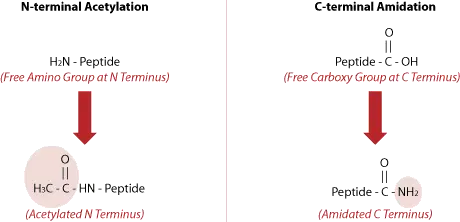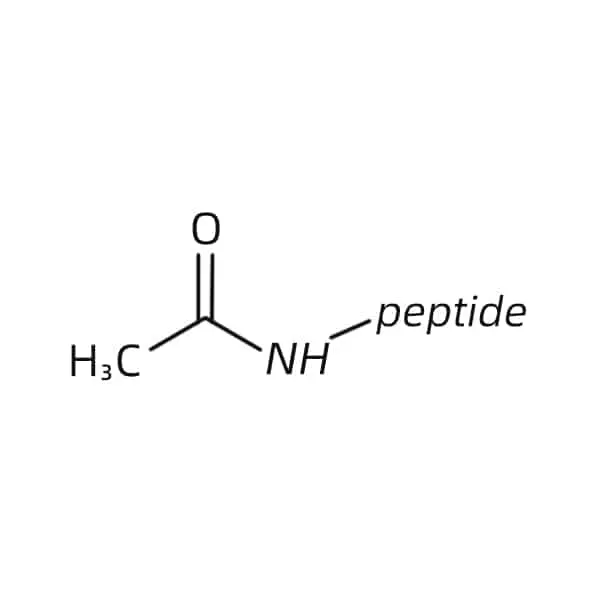
N-terminal acetylation, the covalent addition of an acetyl group (–COCH₃) to a peptide’s N-terminus, is a strategic modification that profoundly influences biological activity, stability, and cellular interactions. This irreversible alteration mimics a widespread natural post-translational modification, offering researchers a tool to optimize peptide performance for specific applications. Whether pursuing therapeutic development, antibody production, or mechanistic studies, the decision for acetylated peptides demands careful evaluation of structural, functional, and experimental objectives.
Key Takeaways
- N-terminal acetylation neutralizes positive charge, enhancing membrane permeability for intracellular applications.
- It increases proteolytic resistance by blocking aminopeptidase degradation, extending half-life.
- Acetylated peptides more closely mimic native proteins, improving relevance in physiological studies.
- Solubility may decrease due to reduced polarity, necessitating formulation optimization.
- Must be specified during synthesis; impossible to add post-synthetically.
Fundamentals of N-Terminal Acetylation
Chemical Mechanism and Biological Rationale
Acetylation replaces the terminal amine (–NH₂) with an acetylated amine (–NHCOCH₃), eliminating its positive charge at physiological pH. This modification occurs naturally in ~85% of eukaryotic proteins, mediated by N-acetyltransferases (NATs). Synthetically, it is achieved using acetic anhydride or acetyl-imidazole during solid-phase peptide synthesis (SPPS), typically as the final step before cleavage. Crucially, unlike in vivo acetylation, synthetic acetylation is non-enzymatic and position-specific, affecting only the N-terminus unless lysine residues are concurrently targeted.
Find out more about peptide synthesis here.
Functional and Structural Implications
Charge Modulation and Membrane Permeability
Charge neutralization reduces electrostatic repulsion with lipid bilayers, facilitating cellular uptake. Acetylated cell-penetrating peptides (CPPs) like Tat (48-60) show enhanced cytosolic delivery, making acetylation advisable for intracellular targeting studies or drug delivery systems. Conversely, the loss of charge can diminish solubility in aqueous buffers, potentially requiring organic co-solvents (e.g., acetonitrile) for reconstitution.
Conformational Stability and Target Interactions
Acetylation often stabilizes α-helical or turn structures near the N-terminus, optimizing receptor-binding interfaces. However, this benefit is sequence-dependent: acetylation may disrupt activity if the N-terminus participates directly in target engagement.
Decision Framework: When to Acetylate
Replicating Native Modifications
Always acetylate if the endogenous counterpart is acetylated (e.g., tropomyosin, actin). Databases can provide annotation for natural acetylation, ensuring biological relevance in antibody generation or functional assays.
Application-Specific Considerations
- Intracellular studies: Acetylation is strongly advised to boost cellular uptake and stability.
- Antibody production: Avoid if epitopes include the N-terminal charge; otherwise, acetylation may improve immunogen stability without altering epitope conformation.
- In vitro enzymology: Use for protease substrates to isolate cleavage specificity away from N-terminal degradation.
- Therapeutic peptides: Balance stability gains against potential solubility challenges and bioavailability requirements.

Synthesis and Analytical Verification
Solid-Phase Synthesis Protocol
Acetylation is performed on-resin before cleavage using acetylating reagents (e.g., acetic anhydride/pyridine). LifeTein’s standard protocols utilize Fmoc-SPPS.. The modification adds 42 Da to the peptide mass.
Critical Quality Controls
- Mass spectrometry: Confirm +42 Da shift versus theoretical mass.
- HPLC: Increased retention time reflects reduced polarity.
Find out about high-speed RUSH synthesis.
Frequently Asked Questions (FAQ)
Does acetylation alter immunogenicity?
Generally no. Antibody recognition depends on epitope conformation, not the N-terminal charge. Exceptions exist for antibodies targeting extreme N-terminal epitopes.
How does acetylation cost impact peptide synthesis?
LifeTein can provide acetylation at no additional cost to the synthesis.
Can lysine residues be acetylated concurrently?
Yes, but requires orthogonal protection (e.g., Alloc on lysine) during SPPS. Standard acetylation targets only the N-terminus.
Is acetylation reversible?
No. Acetylation is a permanent modification with no known mammalian deacetylases acting on N-termini.
